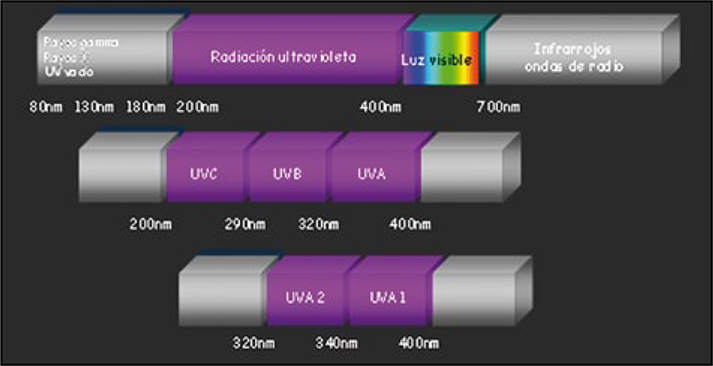Photoprotection
Keywords:
photoprotection, ultraviolet radiation, UVA, UVB, sunscreenAbstract
Ultraviolet radiation from the sun is the prime cause of skin cancer. The Earth receives 20 times more ultraviolet radiation (UV) than ultraviolet B (UVB), but it depends on the time of the day, latitude and atmospheric conditions. Both the UVA and UVB the cause genetic mutations, immunosuppression, these two biological events caused by UVR can trigger in cancer. With the advent of sunscreens, the need to create increasingly appropriate substances and new strategies for photoprotection, which described later, has been the prevention of diseases caused directly by the UVR.
Author Biographies
María Isabel Moreno
Médica dermatóloga, Universidad del Valle, Cali, Colombia
Luis Hernando Moreno
Médico dermatólogo; jefe, Servicio de Dermatología, Universidad del Valle, Cali, Colombia.
References
2. Rigel DS, Rigel EG, Rigel AC. Effects of altitude and latitude on ambient UVB radiation. J Am Acad Dermatol. 1999;40:114-6.
3. Kromann N, Wulf HC, Eriksen P, Brodthagen H. Relative ultraviolet spectral intensity of direct solar radiation, sky radiation and surface reflections. Relative contribution of natural sources to the outdoor UV irradiation of man. Photodermatol. 1986;3:73-82.
4. Moise AF, Aynsley R. Ambient ultraviolet radiation levels in public shade settings. Int J Biometeorol. 1999;43:128-38.
5. Gilchrest BA, Soler NA, Hawk JLM, Barr RM, Black AK, HensHatch KL, et al. Garments as solar ultraviolet radiation screening materials. Dermatol Clin. 2006;24:85-100.
6. Melnikova VO, Ananthaswamy HN. Cellular and molecular events leading to the development of skin cancer. Mutat Res. 2005;571:91-106.
7. Agar NS, Halliday GM, Barnetson RS, et al. Falta citar tres autores. The basal layer in human squamous tumors harbors more UVA than UVB fingerprint mutations: a role for UVA in human skin carcinogenesis. Proc Natl Acad Sci USA. 2004;101:4954-9.
8. Djavaheri-Mergny M, Mergny JL, Bertrand F, Santus R, Mazière C, Dubertret L, et al. Ultraviolet-A induces activation of AP-1 in cultured human keratinocytes. FEBS Lett. 1996;384:92-6. www.revistasocolderma.com 39 Rev Asoc Colomb Dermatol. 2010; 18: 31-39. Fotoprotección
9. Ullrich SE. Mechanisms underlying UV-induced immune suppression. Mutat Res. 2005;571:185-205.
10. Halliday GM, Byrne SN, Kuchel JM, Poon TS, Barnetson RS. The suppression of immunity by ultraviolet radiation: UVA, nitric oxide and DNA damage. Photochem Photobiol Sci. 2004;3:736-40.
11. Granstein RD, Matsui MS. UV radiation-induced immunosuppression and skin cancer. Cutis. 2004;74:4-9.
12. Armstrong BK, Dore JF, Ananthaswamy HN, Arlet C, Autier P, Crowell JA, Diffey BL et al. IARC Handbooks of Cancer Prevention, Volume 5: Sunscreens. Lyon: International Agency for Research on Cancer, 2001. P.149
13. McKinlay AF, Diffey BL. A reference action spectrum for ultraviolet induced erythema in human skin. CIE J. 1987;6:17-22.
14. Stenberg C, Larko O. Sunscreen application and its importance for the sun protection factor. Arch Dermatol. 1985;121:1400-2.
15. Azurdia RM, Pagliaro JA, Diffey BL, Rhodes LE. Sunscreen application by photosensitive patients is inadequate for protection. Br J Dermatol. 1999;140:255-8.
16. Wright MW, Wright ST, Wagner RF. Mechanisms of sunscreen failure. J Am Acad Dermatol. 2001;44:781-4.
17. Diffey BL, Grice J. The influence of sunscreen type on photoprotection. Br J Dermatol. 1997;137:103-5.
18. Nash JF. Human safety and efficacy of ultraviolet filters and sunscreen products. Dermatol Clin 2006: 24: 35–51.
19. Cross SE, Innes B, Roberts MS, Human skin penetration of sunscreen nanoparticles: in vitro assessment of a novel micronized zinc oxide formulation. Skin Pharmacol Physiol. 2007;20:148-54.
20. Dondi D, Albini A, Serpone N. Interactions between different solar UVB/UVA filters contained in commercial suncreams and consequent loss of UV protection. Photochem Photobiol Sci. 2006;5:835-43.
21. Wang S, Balagula Y, Osterwalder U. Photoprotection: a review of the current and future technologies. Dermatologic Therapy. 2010;23:31-47.
22. Schulz J, Hohenberg H, Pflucker F, Gärtner E, Will T, Pfeiffer S, et al. Distribution of sunscreens on skin. Adv Drug Deliv Rev. 2002;54(Suppl.1):S157-63.
23. Russo P, Halliday GM. NO and ROS inhibition in sunscreen photoprotection. Br J Dermatol. 2006;155:408-15.
24. Verschooten L, Claerhout S, Laethemii A, Agostinis P, Garmyn M. New strategies of photoprotection. Photochem and Photobiol. 2006;82:1016-23.
25. Murray JC, Burch JA, Streilein R, Iannacchione M. A topical antioxidant solution containing vitamins C and E stabilized by ferulic acid provides protection for human skin against damage caused by ultraviolet irradiation. J Am Acad Dermatol. 2007;59:418-25.
26. Norval M, Wulf HC. Does chronic sunscreen use reduce vitamin D to insufficient levels? Br J Dermatol. 2009;161:732-6.
How to Cite
Downloads

Downloads
Published
How to Cite
Issue
Section
| Article metrics | |
|---|---|
| Abstract views | |
| Galley vies | |
| PDF Views | |
| HTML views | |
| Other views | |






